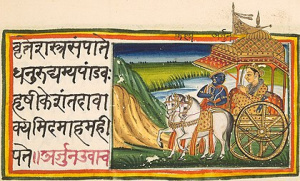Difference between revisions of "Language/Sanskrit/Vocabulary/Colors"
m (Quick edit) |
m (Quick edit) |
||
| (One intermediate revision by one other user not shown) | |||
| Line 8: | Line 8: | ||
__TOC__ | __TOC__ | ||
<span link>Consider exploring these related pages after completing this lesson: [[Language/Sanskrit/Vocabulary/Count-to-10|Count to 10]], [[Language/Sanskrit/Vocabulary/Food|Food]], [[Language/Sanskrit/Vocabulary/Days-of-the-Week|Days of the Week]] & [[Language/Sanskrit/Vocabulary/Feelings-and-Emotions|Feelings and Emotions]].</span> | |||
== Basic Colors == | == Basic Colors == | ||
| Line 79: | Line 81: | ||
<hr>➡ If you have any questions, please ask them in the comments section below.<br>➡ Feel free to edit this wiki page if you think it can be improved. 😎 | <hr>➡ If you have any questions, please ask them in the comments section below.<br>➡ Feel free to edit this wiki page if you think it can be improved. 😎 | ||
<span link>Excellent job on conquering this lesson! Consider delving into these related pages: [[Language/Sanskrit/Vocabulary/Fruits|Fruits]], [[Language/Sanskrit/Vocabulary/Animal|Animal]], [[Language/Sanskrit/Vocabulary/Geography|Geography]] & [[Language/Sanskrit/Vocabulary/Months-of-the-year|Months of the year]].</span> | |||
{{#seo: | {{#seo: | ||
|title=Sanskrit Vocabulary - Colors | |title=Sanskrit Vocabulary - Colors | ||
| Line 91: | Line 88: | ||
|description=In this lesson, you will learn the names of the most common colors in Sanskrit. Use this vocabulary words in sentences, shopping or describing something in your daily conversation. | |description=In this lesson, you will learn the names of the most common colors in Sanskrit. Use this vocabulary words in sentences, shopping or describing something in your daily conversation. | ||
}} | }} | ||
==Videos== | ==Videos== | ||
| Line 105: | Line 100: | ||
<youtube>https://www.youtube.com/watch?v=MHZeOPHsay4</youtube> | <youtube>https://www.youtube.com/watch?v=MHZeOPHsay4</youtube> | ||
==Other Lessons== | |||
== | |||
* [[Language/Sanskrit/Vocabulary/How-to-Say-Hello-and-Greetings|How to Say Hello and Greetings]] | * [[Language/Sanskrit/Vocabulary/How-to-Say-Hello-and-Greetings|How to Say Hello and Greetings]] | ||
* [[Language/Sanskrit/Vocabulary/Count-to-10|Count to 10]] | * [[Language/Sanskrit/Vocabulary/Count-to-10|Count to 10]] | ||
| Line 117: | Line 111: | ||
* [[Language/Sanskrit/Vocabulary/Clothes|Clothes]] | * [[Language/Sanskrit/Vocabulary/Clothes|Clothes]] | ||
* [[Language/Sanskrit/Vocabulary/Plants|Plants]] | * [[Language/Sanskrit/Vocabulary/Plants|Plants]] | ||
<span class='maj'></span> | <span class='maj'></span> | ||
| Line 125: | Line 118: | ||
{{Sanskrit-Page-Bottom}} | {{Sanskrit-Page-Bottom}} | ||
<span links></span> | |||
Latest revision as of 20:40, 27 March 2023
Hi Sanskrit learners! 😊 In this lesson, you will learn the names of the most common colors in Sanskrit. Color knowledge is essential to communicate while shopping or describing something. You can use this vocabulary words in sentences as well.
Consider exploring these related pages after completing this lesson: Count to 10, Food, Days of the Week & Feelings and Emotions.
Basic Colors[edit | edit source]
Here are the most basic colors:
| Sanskrit | Pronunciation | English |
|---|---|---|
| लोहितः (lohitaḥ) | lo-hi-tah | Red |
| हरितः (haritaḥ) | ha-ri-tah | Green |
| नीलः (nīlaḥ) | nee-lah | Blue |
| कपिलः (kapilaḥ) | ka-pi-lah | light brown |
| पीतः (pītaḥ) | pee-tah | Yellow |
| श्वेतः (śvetaḥ) | sh-vay-tah | White |
| कृष्णः (kṛṣṇaḥ) | kr-sh-nah | Black |
Bright Colors[edit | edit source]
Here are some bright colors in Sanskrit vocabulary:
| Sanskrit | Pronunciation | English |
|---|---|---|
| स्पर्धा (spardha) | spar-dha | Pink |
| किङ्किणिः (kiṅkiṇiḥ) | king-ki-nih | Orange |
| रक्तवर्णः (raktavarṇaḥ) | rak-ta-var-naḥ | Crimson |
| सुरण्यः (su-ra-ṇyaḥ) | su-ra-ṇyaḥ | Bright yellow |
Dark Colors[edit | edit source]
Here are some dark colors in Sanskrit vocabulary:
| Sanskrit | Pronunciation | English |
|---|---|---|
| ताम्र (tāmra) | taa-mra | Brown |
| श्याम (śyāma) | sh-ya-ma | Dark green |
| गौरः (gauraḥ) | gow-rah | Light yellow |
| असितः (asitaḥ) | a-si-tah | Gray |
Dialogue[edit | edit source]
Person 1: किमर्थं नीलस्य रूपं? (Kimartham nīlasya rūpam? - What's the appearance of blue?) Person 2: नीलं विस्तीर्ण विषय अन्तः काला होती है। (Nīlaṃ vistīrṇa viṣaya antaḥ kālā hotī hai - Blue is the color of vastness, the innermost part of space.) Person 1: अहं श्यामस्य रूपं अनुभवामि। (Ahaṃ śyāmasya rūpam anubhavāmi - I experience the color of dark green.) Person 2: श्याम कणाच्या रूपाचा अस्तित्व आणि त्याचे भाव खूप उदार आहेत. (Śyāma kaṇācyā rūpācā astitva āṇi tyāche bhāv khup udār āhet - The existence of dark green color and its significance are vast.)
Conclusion[edit | edit source]
Learning different colors' names and their significance in Sanskrit is simple and fun. You can use this vocabulary in your day-to-day conversation with people who know Sanskrit. Include them while describing any object or in shopping. You can also mix the colors to create different and newer ones. To improve your Sanskrit vocabulary, you can also use Polyglot Club. Find native speakers and ask them any questions! Also, don't forget to check out our Vocabulary section for more words and meanings.
➡ If you have any questions, please ask them in the comments section below.
➡ Feel free to edit this wiki page if you think it can be improved. 😎
Excellent job on conquering this lesson! Consider delving into these related pages: Fruits, Animal, Geography & Months of the year.
Videos[edit | edit source]
Learn Sanskrit Visual Dictionary - Colors via Videos by ...[edit | edit source]
वर्णाः ( Sanskrit Names of Colors ) - YouTube[edit | edit source]
Colors in Sanskrit - YouTube[edit | edit source]
Other Lessons[edit | edit source]
- How to Say Hello and Greetings
- Count to 10
- Resources
- Family
- Days of the week
- Animals
- Education
- How to say Good Bye
- Clothes
- Plants
Sources[edit | edit source]
